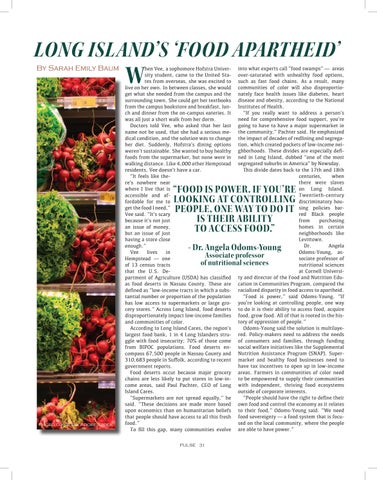LONG ISLAND’S ‘FOOD APARTHEID’ By Sarah Emily Baum
W
hen Vee, a sophomore Hofstra Univer- into what experts call “food swamps” — areas sity student, came to the United Sta- over-saturated with unhealthy food options, tes from overseas, she was excited to such as fast food chains. As a result, many live on her own. In between classes, she would communities of color will also disproportioget what she needed from the campus and the nately face health issues like diabetes, heart surrounding town. She could get her textbooks disease and obesity, according to the National from the campus bookstore and breakfast, lun- Institutes of Health. “If you really want to address a person’s ch and dinner from the on-campus eateries. It need for comprehensive food support, you’re was all just a short walk from her dorm. Doctors told Vee, who asked that her last going to have to have a major supermarket in name not be used, that she had a serious me- the community,” Pachter said. He emphasized dical condition, and the solution was to change the impact of decades of redlining and segregaher diet. Suddenly, Hofstra’s dining options tion, which created pockets of low-income neiweren’t sustainable. She wanted to buy healthy ghborhoods. These divides are especially defifoods from the supermarket, but none were in ned in Long Island, dubbed “one of the most walking distance. Like 4,000 other Hempstead segregated suburbs in America” by Newsday. This divide dates back to the 17th and 18th residents, Vee doesn’t have a car. centuries, when “It feels like thethere were slaves re’s nowhere near on Long Island. where I live that is Twentieth-century accessible and afdiscriminatory houfordable for me to sing policies barget the food I need,” red Black people Vee said. “It’s scary from purchasing because it’s not just homes in certain an issue of money, neighborhoods like but an issue of just Levittown. having a store close Dr. Angela enough.” Odoms-Young, asVee lives in Associate professor sociate professor of Hempstead — one of nutritional sciences nutritional sciences of 13 census tracts at Cornell Universithat the U.S. Department of Agriculture (USDA) has classified ty and director of the Food and Nutrition Eduas food deserts in Nassau County. These are cation in Communities Program, compared the defined as “low-income tracts in which a subs- racialized disparity in food access to apartheid. “Food is power,” said Odoms-Young. “If tantial number or proportion of the population has low access to supermarkets or large gro- you’re looking at controlling people, one way cery stores.” Across Long Island, food deserts to do it is their ability to access food, acquire disproportionately impact low-income families food, grow food. All of that is rooted in the history of oppression of people.” and communities of color. Odoms-Young said the solution is multilayeAccording to Long Island Cares, the region’s largest food bank, 1 in 4 Long Islanders stru- red. Policy-makers need to address the needs ggle with food insecurity; 70% of those come of consumers and families, through funding from BIPOC populations. Food deserts en- social welfare initiatives like the Supplemental compass 67,500 people in Nassau County and Nutrition Assistance Program (SNAP). Super310,683 people in Suffolk, according to recent market and healthy food businesses need to have tax incentives to open up in low-income government reports. Food deserts occur because major grocery areas. Farmers in communities of color need chains are less likely to put stores in low-in- to be empowered to supply their communities come areas, said Paul Pachter, CEO of Long with independent, thriving food ecosystems outside of corporate interests. Island Cares. “People should have the right to define their “Supermarkets are not spread equally,” he said. “These decisions are made more based own food and control the economy as it relates upon economics than on humanitarian beliefs to their food,” Odoms-Young said. “We need that people should have access to all this fresh food sovereignty — a food system that is focused on the local community, where the people food.” To fill this gap, many communities evolve are able to have power.”
“FOOD IS POWER. IF YOU’RE LOOKING AT CONTROLLING PEOPLE, ONE WAY TO DO IT IS THEIR ABILITY TO ACCESS FOOD.” - Dr. Angela Odoms-Young
Photo courtesy Adobe Stock
PULSE 31
